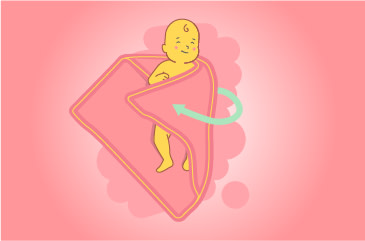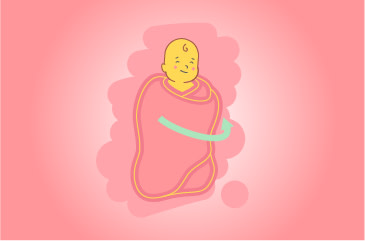What is Swaddling and Why Swaddle a Baby?
Swaddling is an age-old method of wrapping a baby in a blanket in such a way that limits the movement of their arms to suppress the Moro Reflex, otherwise known as the startle reflex.
Newborn infants are just discovering their bodies and have little if any motor control when they first arrive. The Moro Reflex occurs when a baby is sleeping on its back and suddenly jerks both arms sideways with palms up. This will often wake the baby and a parent will need to come in to soothe them again. By learning how to wrap a baby in a swaddle tightly (but not too tightly), their arms will be prevented from moving, the Moro Reflex is subdued, and most infants will sleep more soundly as a result.
Benefits of Swaddling a Baby
Swaddling a baby is good for a number of reasons, including allowing the baby to sleep for longer periods of time uninterrupted.
Swaddling completely covers the feet and hands, allowing baby to stay warm and cozy. It also reduces the risk of SIDs (sudden infant death syndrome) and the constriction of the blanket around your baby will help soothe and calm her, letting both baby and mommy to catch a little shuteye!
How Do I Choose a Proper Blanket for Swaddling?
Muslin, linen, and cotton-blend Proper swaddling blankets work best because they provide warmth while also being breathable enough that your baby will not overheat. Fabrics that work best are:
- Muslin
- Linen
- Cotton-blend
Lighter blankets usually work better simply because they create fewer lumps of thick cloth when tucked underneath the baby. If you prefer, there are also purpose-made swaddle sacks and blankets that may prove easier for some parents to use.
How to Swaddle a Baby Step by Step
Step 1

Lay your swaddle blanket in a diamond pattern with the corners pointing up, down, left, and right. Fold the top corner down toward the center of the blanket. Lay your baby on her back with her shoulders just below the fold and her head outside the blanket.

Step 2

Take her right arm and place it by her side, pulling the right corner of the blanket over her arm and chest, tucking it tightly underneath the left side of her body.

Step 3

Fold the bottom corner of the swaddle up and over baby's feet, tucking the fabric into the top of the swaddle by her shoulder.

Step 4

Take baby's right arm and place it by her side, bringing the left corner of the blanket over her arm and chest, then tucking it tightly underneath the right side of her body.

When Do You Stop Swaddling a Baby?
When to stop swaddling your baby will depend on their own development. It is safe to swaddle until they can roll over in their crib; usually 2–4 months. Once your baby can roll over on his own, it is time to transition out of the swaddle to reduce the risk of them rolling over and suffocating.
If you are looking to transition your child out of a swaddle, there are some techniques you can try to avoid removing the swaddle altogether.
- Align the top fold of your swaddle underneath the baby's armpits to swaddle them with either one or both arms free to move about.
- Lay your baby on her back at the bottom of the crib, then cover them with a blanket and snugly tuck it into the sides and bottom of the crib.
This techniques allows fussy babies the soothing benefits of swaddling while also keeping their arms free to support them should they roll over.
Safety Tips for Swaddling a Baby
While there is nothing inherently dangerous about swaddling your child, you should keep a few things in mind to keep your baby safe. Swaddle tightly, but not too tight. Excessively tight swaddles have been known to cause hip issues in some infants, so care should be taken to ensure proper tightness. If you can fit two or three fingers into the top of the swaddle, you have the perfect tightness.
Parents should also keep an eye out for signs that the swaddle is overheating your baby. Parents should be on the lookout for:
- Shortness of breath
- Sweating
- Damp hair
- Flushed cheeks
These can all be indicators that your baby is overheating in their swaddle. If you suspect your baby is overheating, try using a lighter blanket or pajamas.
Washing tips: How to Wash Swaddle Blanket?
When it comes to swaddling, the main reason parents love to use the technique is for the calming and soothing effect it has on their baby, allowing them to get deeper, more-restful sleep. But just like any other item of baby clothing, your swaddling blankets will eventually become soiled with spit up, drool, or other bodily fluids.
Since your swaddling blanket will be as close to your baby’s skin as the clothing you dress them in, keeping your muslin, wool, or fleece swaddle blankets clean, soft, and soothing to sensitive baby skin means washing them in a baby safe detergent. Avoid harsh detergents with brighteners or optical softeners, keeping in mind that the blanket just needs to be clean and feel soft; its appearance is secondary.
Choosing a hypoallergenic detergent like Dreft will ensure that your child always has fresh, soft, non-irritating swaddle blankets when it’s time for sleep.
FAQs about How to Swaddle a Baby
In the end, how or why you swaddle your baby will come down to personal preference—both for your child and for you. While many children respond positively to swaddling, don’t stress if it does not suit your baby. Also do not be afraid to experiment with partial swaddles (one or both arms exposed) as some children simply prefer to have their arms free while sleeping.

